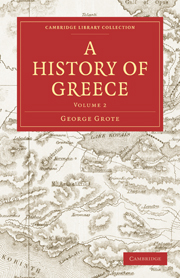Book contents
- Frontmatter
- Contents
- PART I CONTINUATION OF LEGENDARY GREECE
- CHAPTER XVIII Closing events of Legendary Greece.—Period of intermediate darkness, before the dawn of Historical Greece
- CHAPTER XIX Application of Chronology to Grecian Legend
- CHAPTER XX State of Society and Manners as exhibited in Grecian Legend
- CHAPTER XXI Grecian Epic.—Homeric Poems
- PART II HISTORICAL GREECE
- Plate section
CHAPTER XIX - Application of Chronology to Grecian Legend
Published online by Cambridge University Press: 29 August 2010
- Frontmatter
- Contents
- PART I CONTINUATION OF LEGENDARY GREECE
- CHAPTER XVIII Closing events of Legendary Greece.—Period of intermediate darkness, before the dawn of Historical Greece
- CHAPTER XIX Application of Chronology to Grecian Legend
- CHAPTER XX State of Society and Manners as exhibited in Grecian Legend
- CHAPTER XXI Grecian Epic.—Homeric Poems
- PART II HISTORICAL GREECE
- Plate section
Summary
I need not repeat, what has already been sufficiently set forth in the preceding pages, that the mass of Grecian incident anterior to 776 B.C. appears to me not reducible either to history or to chronology, and that any chronological system which may be applied to it must be essentially uncertified and illusory. It was however chronologised in ancient times, and has continued to be so in modern; and the various schemes employed for this purpose may be found stated and compared in the first volume (the last published) of Mr. Fynes Clinton's Fasti Hellenici. There were among the Greeks, and there still are among modern scholars, important differences as to the dates of the principal events: Eratosthenês dissented both from Herodotus and from Phanias and Callimachus, while Larcher and Raoul Rochette (who follow Herodotus) stand opposed to O. Müller and to Mr. Clinton. That the reader may have a general conception of the order in which these legendary events were disposed, I transcribe from the Fasti Hellenici a double chronological table, contained in p. 139, in which the dates are placed in series, from Phorôneus to the Olympiad of Corœbus in B.C. 776—in the first column according to the system of Eratosthenês, in the second according to that of Callimachus.
“The following table (says Mr. Clinton) offers a summary view of the leading periods from Phorôneus to the Olympiad of Corœbus, and exhibits a double series of dates; the one proceeding from the date of Eratosthenês, the other from a date founded on the reduced calculations of Phanias and Callimachus, which strike out fifty-six years from the amount of Eratosthenês.
- Type
- Chapter
- Information
- A History of Greece , pp. 47 - 78Publisher: Cambridge University PressPrint publication year: 2010First published in: 1846

